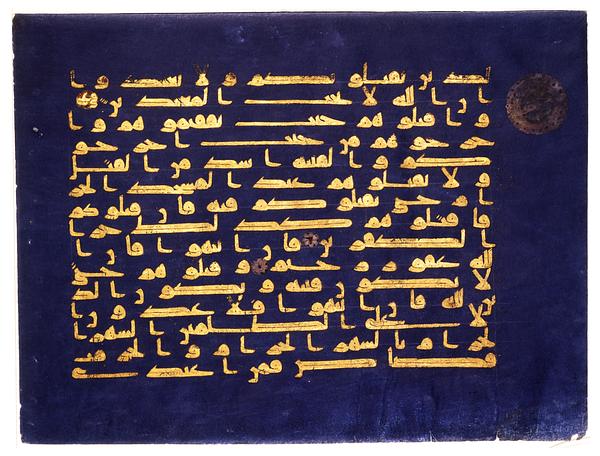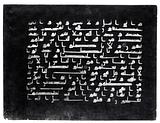Parchment leaf from a Koran written in Kufi
North Africa; c. 900
28.6 × 38 cm
This early Koran is one of its period’s most famous, especially because of the parchment’s blue color, and the script in gold and verse markers in now-decomposed silver. It is difficult to read the text because the spaces between some of the individual letters and between each word are the same. In order to spread the text uniformly over the page, certain letters were moreover lengthened artificially, a practice called mashq.
The Koran has been ascribed to Iraq, Tunisia, Spain, and Sicily, but several features point to its having been made in Tunisia under the Aghlabids (800-909) or the early Fatimids (909-950).
Inv. no. 77/2004
Published in:
Anthony Welch: “The Arts of the Book: The Arab Lands” in Toby Falk (ed.): Treasures of Islam, Musée d’art et d’histoire, Geneve, London 1985, cat. 3;
Sotheby’s, London, 12/10-2004, lot 1;
Sheila S. Blair og Jonathan M. Bloom (eds.): Cosmophilia. Islamic Art from the David Collection, Copenhagen, McMullen Museum of Art, Boston College, Boston 2006, cat. 38;
Marie Rehakova: Koran: vyvoj umelecke tradice, Plzen 2013, fig. 11, p. 44;
Jonathan M. Bloom: “The Blue Koran revisited” in Journal of Islamic manuscripts, 2015, 6:2-3, pp. 196–218;
Stig T. Rasmussen: Klassisk arabisk litteratur i oversættelse til dansk: en litteraturhistorisk vejvisende antologi, København 2018, p. 23;
Jonathan M. Bloom: “Fāṭimid art and architecture” in https://referenceworks.brillonline.com/entries/encyclopaedia-of-islam-3/fatimid-art-and-architecture-COM_27044?s.num=0&s.f.s2_parent=s.f.book.encyclopaedia-of-islam-3&s.q=blue+quran;
Joachim Meyer, Rasmus Bech Olsen and Peter Wandel: Beyond words: calligraphy from the World of Islam, The David Collection, Copenhagen 2024, cat. 44, p. 181;
Rasmus Bech Olsen: “Beyond words: calligraphy from the World of Islam”, Orientations, 55:4, 2024, fig. 5, p. 36;



